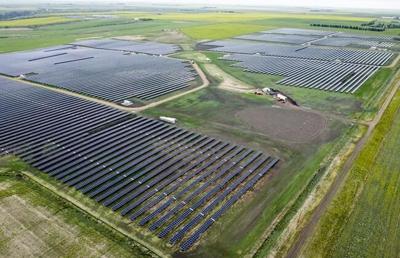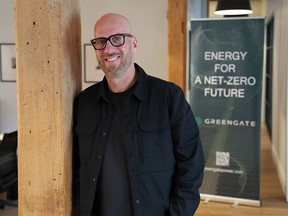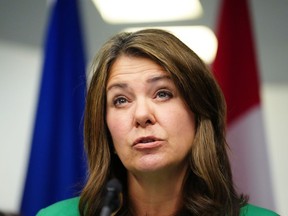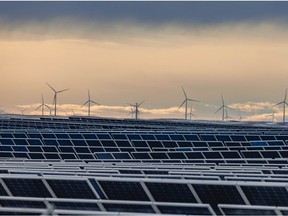Amanda Stephenson The Canadian Press

Solar panels pictured at the Michichi Solar project near Drumheller, Alta., Tuesday, July 11, 2023. A seven-month pause on wind and solar development in Alberta is coming to an end, but some involved in the sector say their industry's future growth in the province is threatened by creeping politicization. THE CANADIAN PRESS/Jeff McIntoshJMC
CALGARY - A seven-month pause on wind and solar development in Alberta is coming to an end, but some involved in the sector say increased politicization threatens its future growth.
The industry was caught off guard last August by the UCP government's move to impose a temporary moratorium on new wind and solar approvals in the province to give it time to study issues related to land use, reclamation and grid reliability.
That moratorium is set to expire Thursday, after which the government is expected to unveil new rules to guide future wind and solar development in the province.
But Dan Balaban, CEO of Greengate Power Corp., said the government-imposed pause on the renewables sector is just one piece of an increasingly contentious public debate that has left the wind and solar industry feeling like a political football.
"This is really about the politics of energy," said Balaban, whose company was behind the development of the Travers Solar farm in southern Alberta, one of the largest solar projects in the world.
"It's very disappointing because I think there are pragmatic solutions to get us to where we ultimately need to be in terms of providing clean, reliable and affordable energy, and the politics of division aren't going to get us there. For me, as an entrepreneur, it's very off-putting."
The government-imposed moratorium was a response to what has been an explosion of growth in the province's renewable energy in recent years. In 2022, 75 per cent of all new wind and solar projects in Canada were built in Alberta, thanks to the province's sunny skies, abundance of wind and unique deregulated electricity market.
But the rapid growth led to questions from rural communities about who would be on the hook to clean up renewable energy infrastructure as well as concerns around the use of food-producing agricultural land for renewable energy development.
Balaban said all of those questions are valid, but Alberta's move to shut down the industry while seeking answers was "a very negative signal."
"It really feels like the renewable energy industry was singled out," he said.
"I agree that all of these things need to be reviewed, but I certainly don't see the same level of scrutiny and negativity being directed toward other industries."
At the time the moratorium was announced, there were 118 renewable energy projects proposed by 64 different development companies either in the permitting stage or about to apply for permitting in Alberta.
Jorden Dye, director of Business Renewables Centre Canada — which works to help businesses and institutions reduce their emissions by connecting buyers and sellers of renewable power — said whether or not the moratorium has a long-term chilling effect on the industry will depend on what regulations are introduced.
"There's a very broad range of changes they (the government) could make, starting with minimal impact all the way up to major impact with a massive reduction in projects," Dye said.
But like Balaban, Dye said he is concerned in general about the public discourse around renewables, which has intensified due to opposition from Alberta and neighbouring Saskatchewan about the federal government's proposed clean electricity regulations.
"I do think it's sad this has become politicized," Dye said. "Not only does it keep us from focusing on the actual issues, it just reduces the level of conversation in the province."
Dye pointed to what happened when Alberta was forced to declare an emergency grid alert during an extreme cold snap in January. Premier Danielle Smith called renewables "unreliable" even though two natural gas-fired power plants were also offline at the time, while Saskatchewan Premier Scott Moe said on social media that power exports from his province to Alberta would be coming from "natural gas and coal-fired plants, the ones the Trudeau government is telling us to shut down (which we won't)."
Vittoria Bellissimo, president and CEO of the Canadian Renewable Energy Association, said she was discouraged by the number of "hot takes" the grid advisory sparked and said she has been working hard to increase the UCP government's understanding of renewable energy generally.
"It's not one type of energy versus another type of energy here. We have oil and gas producers who buy renewables to satisfy their electricity needs and ESG obligations. We have natural gas-fired generators who also produce renewables," she said.
"There is no line in the sand, or us versus them."
Balaban said he thinks his industry has been damaged by the "hostile rhetoric" between the province and the federal government over net-zero goals, which is taking momentum away from the growth of the renewables sector in Alberta.
He said his own company is not pursuing any new developments in Alberta until it is confident that any forthcoming new rules for the sector will be "clear, fair and objective."
"You know, increasingly in the world we're seeing ourselves being defined by division on major issues," he said.
"Energy is just one of those major issues and arguably one of the most important ones in Alberta. And this is unfortunately how it's playing out."
This report by The Canadian Press was first published Feb. 28, 2024.
Alberta gives cold shoulder to wind and solar industry, as the rest of the world is clamouring for more
Province will lift ban on new projects this week and begin introducing new rules
The Alberta government's seven-month ban on new large-scale wind and solar power projects will end this week, but the province is unlikely to return to its previous status as a hotbed of investment.
Alberta is known for its sunshine and strong winds, especially in the southern region of the province. Those conditions combined with a deregulated electricity system helped drive a flurry of activity in the last decade.
In 2022, more than three-quarters of all the wind and solar built in the country was located in Alberta. Solar and wind now account for about 30 per cent of installed electricity capacity in the province.
Last summer, the Alberta government decided to hit the brakes on the thriving sector by introducing a moratorium on approving any new proposals while launching an inquiry to examine issues including the impact on agricultural land, concerns about reliability and the need for mandatory reclamation.
While the ban lifts this week, the Alberta Utilities Commission (AUC) is awaiting direction from the provincial government about how to proceed. There will be new rules placed on the wind and solar sector.
Globally, the solar industry, in particular, is growing rapidly, with investments even outpacing the oil and natural gas industry last year as the cost of panels has fallen in recent years.
"Alberta hit pause in the midst of a growth curve, and Alberta was the No. 1 destination in Canada for solar investment," said Thomas Timmins, a Toronto-based commercial lawyer with Gowling WLG serving clients in renewable energy project development and finance.
"It's hard to say" whether companies will return to the province, he said, because Alberta's reputation took a hit as an investment destination.
While Alberta rethinks how much renewable electricity it wants and what restrictions to place on the sector, other governments in Canada, the United States and around the world are competing to attract investment to grow their amount of solar and wind power.
"It's a global industry and it's a highly liquid and fluid industry. So Alberta is competing not just with Saskatchewan, not just with Manitoba, not [just] with Ontario, not [just] with Nova Scotia and Quebec, but also with every U.S. state," said Timmins.
The pause on approvals for new renewable energy projects is affecting 118 projects worth $33 billion of investment in Alberta, according to the Pembina Institute, a clean-energy think-tank.
Easy to invest elsewhere
The Sharp Hills wind farm is the newest large-scale renewable energy project in Alberta, after nearly 70 turbines began operating in January. The nearly 300-megawatt project is located near the town of Sedalia, about 300 kilometres east of Calgary, and was unaffected by the province's moratorium because it was already approved and under construction.
The wind farm was developed by EDP Renewables, which is also pursuing a new 150-megawatt solar project in the southeast corner of the province near Medicine Hat. The company intends to apply to begin the permitting process soon.
"I find it a bit strange to have a moratorium on certain technologies rather than all technologies, if what's needed is a pause," said Thomas LoTurco, an Indianapolis-based executive vice-president with the company, about Alberta's wind and solar ban.
LoTurco says he's worried about a backlog of projects seeking approval in the province and about delays in developing projects.
While EDP pursues its proposed solar farm in Alberta, it's just one of many projects on the go.
EDP is a global renewable energy company operating in 28 different markets around the world, including France, Brazil and Vietnam.
In North America alone, the company has 3,000 megawatts of projects currently under construction and another 30,000 megawatts of projects in the planning stages. EDP aims to build about 1,500 to 2,000 megawatts of projects every year in North America.
Many provincial and state governments across North America recognize the need for renewable energy, said LoTurco, as electricity consumption climbs. He pointed to Ontario as an example, since the province announced in December its intention to secure 5,000 megawatts of renewable electricity, its first major renewables procurement in seven years.
"It's just a realization in a place like Ontario — that realization will hit everybody, that we're getting more electrified going forward," he said.
Reliable power
Alberta's premier isn't so sure.
Danielle Smith wants more power plants, but not necessarily wind and solar because of their intermittency.
"We have to make sure that we're bringing on a responsible amount of solar and wind so that we always have dispatchable power,... things like nuclear and hydroelectric, geothermal and natural gas," she said on CBC's Power & Politics.
"That's got to be the basis for how we build our system, and then solar and wind can augment," added Smith.
The province's inquiry was split into two parts. The first report was received in January, while the second is due by the end of March.
The provincial government will announce some regulatory changes in the coming days.
"The Alberta government will be setting a clear and responsible path forward for renewable energy development. This will begin ahead of the approvals pause lifting," said Ashley Stevenson, press secretary to Utilities Minister Nathan Neudorf, in an emailed statement.
After the government receives the second inquiry report next month, it will "continue announcing the next steps forward to enhance the energy market. These policies will apply to project approvals going forward," said Stevenson.
In the meantime, some companies have shifted their focus away from Alberta since the moratorium was announced.
BluEarth Renewables put on hold its projects (of about 400 megawatts) in the province and instead invested in renewable energy facilities in other Canadian provinces and U.S. states.
"The moratorium basically threatened a very strong, open market," said company president Grant Arnold.
"We will invest here when conditions allow us to do so," he said.
But first, he'll need to see how any new rules will impact the cost and time it takes to develop a project. Arnold said there will also need to be fairness and stability toward wind and solar companies compared to other electricity producers in the province.
With the freeze expected to end this week, wind and solar developers will be watching to ensure projects aren’t facing extraordinary new rules or barriers that other industries don’t face
Author of the article:Chris Varcoe • Calgary Herald
Published Feb 26, 2024 •

Alberta’s controversial pause on approving new renewable energy projects will end Thursday and industry developers say they’re looking for one principle to guide its outcome and future investment in their sector.
Equitable treatment.
The industry was stunned by the UCP government’s decision last August to place a moratorium on approving new renewable projects while it examines policy issues surrounding the sector’s rapid expansion.
With the freeze expected to end this week, wind and solar developers will be watching to ensure projects aren’t facing extraordinary new rules or barriers that other industries don’t face when it comes to accessing land, or mandatory remediation requirements once a facility reaches the end of its life.
“Those are all valid things to review in the context of a fast-growing industry like renewables, but the moratorium was unnecessary,” said Dan Balaban of Calgary-based Greengate Power, one of the largest renewable developers in the province.
“That didn’t seem like a fair move to me. So, I hope that whatever comes out of the inquiry will be fair.”
The Alberta Utilities Commission (AUC) has examined the sector’s speedy development and the implications of its growth on the use of prime farmland for wind and solar farms, along with the effect on “Alberta’s pristine viewscapes,” and the possibility of mandatory reclamation security requirements for new projects.
In 2022, Alberta’s deregulated energy market was home to more than 75 per cent of all newly installed renewable energy capacity added in Canada, growing to more than 90 per cent last year, according to the Canadian Renewable Energy Association.
Alberta added 1.7 gigawatts (GW) of installed renewable capacity in 2023, as previously approved projects weren’t affected by the moratorium.
At the time, Affordability and Utilities Minister Nathan Neudorf said the pause was necessary as “Alberta has a bit of a Wild, Wild West feel to it,” with a surge of projects brought before the AUC.
She also suggested Alberta’s plan would need to ensure money is set aside by operators for future cleanup costs.
“It is totally appropriate to talk about the need for all industrial projects to post some kind of security, but conventional oil and gas doesn’t need to post some kind of security,” said Simon Dyer, deputy executive director of the Pembina Institute, which has called for equitable treatment for clean energy developments in the province.
“I imagine Alberta would be the only jurisdiction in the world to consider renewable energy riskier than oil and gas development.”
On a weekend radio program, Smith reiterated the pause will come off Thursday and said the province will provide more clarity about adding renewables to the electricity grid in the future.
She also pointed to the extreme cold weather last month, when the province’s grid operator issued an emergency alert and considered imposing rolling blackouts amid high power use and a lack of electricity generation.
“We need to bring on a responsible amount of wind and solar and always ensure that we have enough baseload dispatchable power so that it can be backed up. So, it might be a slower pace of growth,” the premier said.

The Canadian Renewable Energy Association recommends there not be any retroactive policy changes that affect projects already built or filed with the AUC.
The industry group is calling for the government to adopt “reasonable” reclamation security requirements — using estimates made by experts in the field — and it opposes a blanket ban on land use for new projects, said Evan Wilson, vice-president of policy with the Canadian Renewable Energy Association.
“Let’s move forward in a way that is constructive and not about the government deciding what we can and can’t do, but more about providing transparency on how we are doing,” Wilson said Monday.
Many players in the industry note that rural landowners decide if they want to strike agreements that allow wind or solar developments on their property.
Rural Municipalities of Alberta president Paul McLauchlin said he hopes to see standardized rules around reclamation — some agreements with landowners already include them — and he points out land use needs to involve community planning conversations.
“I fully believe in landowner rights but, at the same time, also believe in landowner rights for your neighbour. The fact is, you can’t do whatever you want on your land,” said McLauchlin, who is also the reeve of Ponoka County.
“This is a good day for renewables. I think the opportunity is still there and it will never go away. And it requires just a little more front-end, sophisticated discussion by the industry, landowners, as well as the regulator.”

Aside from renewable development, the provincial government is also reviewing the overall design of the electricity market in Alberta, and other aspects of the power system.
The head of TransAlta Corp., the province’s largest power generator, which has both renewable and gas-fired units, said stability is critical to making long-term investment decisions.
“We’re close to getting some of that certainty or clarity from an Alberta market perspective over the course of the next probably 45 days or so,” TransAlta CEO John Kousinioris said Friday on an analysts’ call.
Greengate, which developed the country’s largest solar farm — the Travers Solar Project, southeast of Calgary in Vulcan County — is also waiting to see what comes out of the ongoing examinations.
Any decisions coming out of the pause will influence how it views future investment opportunities in its home province.
“What we really need to do is get through those reviews as soon as we reasonably can, put in a set of rules that are fair and let the industry get back to doing what it does,” Balaban said.
“We’re waiting to see how things unfold before we decide if we’re going to invest in any new renewable projects in Alberta.”
Chris Varcoe is a Calgary Herald columnist.
cvarcoe@postmedia.com
RECOMMENDED FROM EDITORIAL

Wind and sun come through to help Alberta electricity operator end extreme-cold grid alerts

Premiers attack Ottawa's renewables plans as cold weather strains Alberta’s electricity grid

Alberta’s renewable energy pause could become lingering stumble, observers say

Renewables pause in Alberta affecting 118 projects worth $33 billion, think tank says






No comments:
Post a Comment